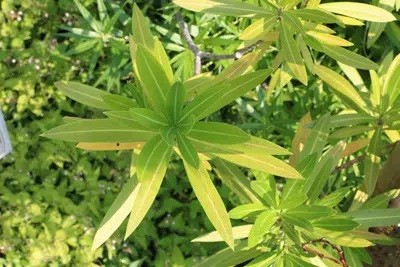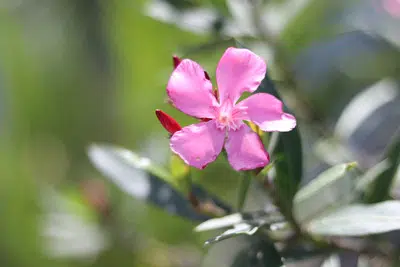The oleander is an evergreen plant, and these evergreen plants do not keep their leaves all their life, but in between they always drop leaves, which are replaced by new ones. Each plant has a slightly different rhythm in which it gets rid of the oldest leaves, they then turn yellow and the oleander subsequently discards them after some time.
So if you haven’t had your oleander long, you should just watch the yellow leaves for a while, maybe nature is just taking its course here….
You can stop this natural yellowing only by constant rejuvenation pruning, see below, and that too not completely, at some point the leaves are just too old.
Contents
- 1 Wrong location or change of location
- 2 Nutrient deficiency
- 3 Yellow leaves due to lack of water in the oleander.
- 4 Yellow leaves as a result of wrong wintering of the oleander
- 5 Wrong container
- 6 Pruned incorrectly or too little?
- 7 Yellow leaves due to pests or diseases
- 8 The treatment of yellow leaves on the oleander.
- 9 Conclusion
- 10 Author
Wrong location or change of location
Surely you have given your oleander a nice warm and sunny spot in the summer, but what is sometimes forgotten is that the oleander also does not like wind. If it’s not sheltered enough from the wind, it could cause yellow leaves that won’t grow back until it’s in a more congenial location.
In addition, an oleander more often reacts with yellow leaves when it has been subjected to a change of location. Even the change of location from winter quarters to summer quarters can be enough, if it happens too abruptly. If it happened, there is not much you can do, the next time you should prepare your oleander for the summer season in stages.
Nutrient deficiency
Of course, it depends decisively on how many leaves turn yellow in what time – if very many leaves turn yellow in quite a short time, it is certainly no longer natural aging. If the yellow leaves appear evenly distributed, the oleander usually suffers from nutrient deficiency.
This happens quite quickly, because oleander plants are highly nutritious. In their natural habitats on riverbanks, they are often flooded, in this water every time are a lot of nutrients and a lot of lime. Therefore, oleander should actually already be planted in soil with a slightly alkaline or at least neutral pH (between 6 and 8.3), and some nutrient-rich compost should also be mixed in, preferably a little clay.
If this was missed, the oleander must be fertilized all the more, at least once or even twice a week during the growing season with normal fertilizer or slow-release fertilizer at the beginning of the season. The fertilizer should contain a lot of nitrogen and a lot of potassium, a NPK mixture 15/8/12 (15% nitrogen, 8% phosphate, 12% potassium) could please the oleander, for example, in the tub best still with trace elements and magnesium.
If there are omissions here, an oleander quickly develops yellow leaves once, then you should touch up and will have to wait a while until the deficiency symptoms grow out.

Yellow leaves due to lack of water in the oleander.
And it depends on where the leaves turn yellow – discoloration and leaf loss can also be caused by a lack of water in the oleander, an indication of this is when the miscoloration starts inside the oleander. The genus name of oleander gives the first appropriate clue here: oleander belongs to the genus Nerium, and that comes from the Latin nerium = wet. In nature, oleanders prefer to grow in valleys through which flowing waters pass, it is one of the few plants that do not mind waterlogging, on the banks of rivers it is constantly flooded and the roots usually grow into the groundwater area anyway.
An oleander also needs plenty of water from above, in warm weather rather too much than too little, also in this it differs from most other houseplants or potted plants. Once the soil in the pot really dries out, this later leads to supply problems and thus often to yellow leaves.
These will eventually disappear again if the oleander gets enough water from now on. You can prevent this by keeping the oleander with a saucer under the pot, which is always filled with a few inches of water.
You may have done too well in another direction, namely if you live in an area with very hard, chalky water and avoid watering the plants with this tap water if possible. For most plants this is true, they like lime-free rainwater better, but not for the oleander, which usually likes lime-rich water very much. But be careful, only try it if signs point to it, there are now cultivated forms that love the soft rainwater.
Yellow leaves as a result of wrong wintering of the oleander
An oleander wants to be kept cool in winter, with less water and without fertilizer, between 5 and 10 degrees, if it had to survive a wintering in the heated living room, this can also lead to yellow leaves. If you have to overwinter your oleander in the living room or maybe even dark and warm because you don’t have a cool bright room, you should put it away as late as possible from the summer freshness and also put it out again as early as possible, otherwise the lack of light will always cause yellow leaves.
This was true for the oleander in the container, if you live in a mild region and planted one of the hardy oleander varieties in the garden, it could simply be that the “mild region” last winter turned out to be not mild enough after all, or that the winter protection was not enough. Oleander in the garden is always critical in Europe, we can offer at most USDA winter hardiness zone, which is the absolute lowest limit for an oleander used to winter hardiness zone 10, and these winter hardiness zones always give only average values. Then it could be that your oleander not only develops yellow leaves, but largely dies above ground, then you can only wait and see if it sprouts again in the spring, and give it better winter protection next year.
Wrong container
If your oleander “lives” in a tub, it needs the right soil. Garden soil is best, possibly raised in pH with lime, with compost mixed in and some clay for nutrients.
It also needs space in the container, enough space to develop its roots. Young plants usually need a larger tub every year, older plants always when the soil in the tub consists almost only of roots, if you were too slow here, your oleander could also acknowledge this with yellow leaves.
Then repotting and wait is announced, if your oleander already sits in the largest possible tub, as much earth as possible is taken out and filled up with fresh earth, you should also prune roots and shoots at the same time.
Pruned incorrectly or too little?
Perhaps your problem child is an oleander that has been given too little attention for a long time. In this case, regular pruning was usually not carried out, and the oleander urgently needs it.
This omitted pruning then ensures, so to speak indirectly, that the oleander gets yellow leaves: oleander is a woody plant, if it is allowed to grow without pruning, first the branches in the interior become woody, while still in the outer, directly exposed to light area of the oleander new shoots with young leaves are formed. Where the shoots become lignified, leaves of considerable age are then quickly on the shoot, and these just die off at some point. Only if you regularly prune the oldest shoots of the oleander, it can develop new young shoots all around, on which there are also new young leaves that do not turn yellow.
If your oleander is already quite bare, only a radical cure will help, you cut back the entire shrub to the root, except for a few strong young shoots, which will retain about 20 cm in length. From these, the oleander will now develop anew, with fresh green leaves.
This should really only happen to you if you’re dealing with a red or pink flowering oleander, white and yellow flowering varieties should keep forming new shoots from the base, making them unlikely to go bald.
Yellow leaves due to pests or diseases
Oleander can be infested – especially during wintering – by scale insects, thrips or spider mites, which can also cause yellow leaves and must be controlled.
The treatment of yellow leaves on the oleander.
Depending on how many yellow leaves you need to eliminate, you can simply cut away the yellow leaves as part of your normal spring pruning, or use the deformity as an opportunity to subject your oleander to radical rejuvenation pruning – which may have been due for some time.
Conclusion
Yellow leaves on the oleander are bound to appear at some point if you bring this decorative flowering plant into your home. There’s no need to panic – a few yellow leaves will appear during the course of normal growth, and if more appear, you’ll just have to figure out where the care isn’t optimal. “Oleander” comes from olea = oil and andreios = strong and vigorous, this plant actually always recovers.


